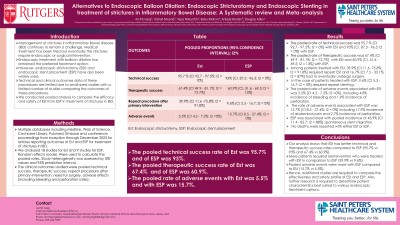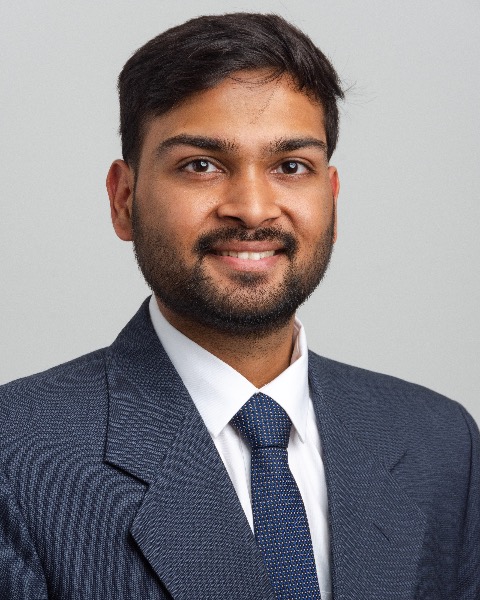Tuesday Poster Session
Category: IBD
P4368 - Alternatives to Endoscopic Balloon Dilation: Endoscopic Stricturotomy and Endoscopic Stenting in treatment of strictures in Inflammatory Bowel Disease: A Systematic Review and Meta-Analysis
Tuesday, October 29, 2024
10:30 AM - 4:00 PM ET
Location: Exhibit Hall E

Has Audio

Archit Garg, MD
Saint Peter's University Hospital
New Brunswick, NJ
Presenting Author(s)
Archit Garg, MD1, Vishali Moond, MD1, Tejas Nikumbh, MD2, Babu Mohan, MD3, Arkady Broder, MD1, Douglas Adler, MD4
1Saint Peter's University Hospital, New Brunswick, NJ; 2The Wright Center for Graduate Medical Education, Scanton, PA; 3Orlando Gastroenterology PA, Orlando, FL; 4Center for Advanced Therapeutic (CATE), Centura Health, Porter Adventist Hospital, Peak Gastroenterology, Denver, CO
Introduction: Management of strictures in Inflammatory Bowel disease (IBD) continues to remain a challenge. Medical treatment has been tried but eventually the strictures require endoscopic or surgical intervention. Endoscopic treatment with balloon dilation has remained the preferred treatment option but endoscopic stricturotomy (ESt) and endoscopic stent placement (ESP) have also been widely used.
Methods: We searched multiple databases including Medline, Web of Science, Cochrane Library, Pubmed, Embase and conference proceedings from inception through December 2023 for articles reporting outcomes following ESt and ESP for benign lower gastrointestinal stricturing disease in patients with IBD. The clinical outcomes studied were pooled technical success, clinical success and adverse events. Standard meta-analysis methods were employed using the random-effects model, and heterogeneity was studied by I2 statistics.
Results: 18 studies were analyzed for ESt and 9 studies for ESP. The pooled technical success rate for ESt and ESP was 95.7 % [CI 92.7 - 97.5%; I2 = 0%] and 93% [CI, 87.3 - 96.3; I2 = 0%] respectively. The pooled therapeutic success rate for ESt was 67.4% [CI 49.9 - 81.1%; I2 = 72.7%] and for ESP was 60.9% [CI, 51.6 - 69.5; I2 = 13%]. Among patients treated with ESt, 39.9% [Cl 11.6 -75.8%; I2 = 91.8%] required repeat ESt and 16.7% [Cl 7.5 - 33.1%; I2 = 87%] had to eventually undergo surgery. In the case of patients treated with ESP, 9.6% [CI 5.3 - 16.7; I2 = 0%] required repeat stenting. The pooled rate of adverse events associated with ESt was 5.5% [Cl 4.2 - 7.2%; I2 =0%], including 4.8% incidence of bleeding and 1.9% incidence of perforation. The rate of adverse events associated with ESP was 15.7% [Cl 8.5 - 27.4%; I2 = 0%] including 17.9% incidence of abdominal pain and 2.7% incidence of perforation. ESP was associated with pooled incidence of 43.9% [CI 11.4 - 82.7; I2 = 88%] spontaneous stent migration. No deaths were reported with either ESt or ESP.
Discussion: Our analysis shows that ESt has better technical and therapeutic success rates compared to ESP (95.7% vs 93% and 67.4% vs 60.9%). More patients required reintervention who were treated with ESt in comparison to ESP (39.9% vs 9.6%). However, adverse events were more with ESP compared to ESt (15.7% vs 5.5%). Hence, additional studies are required to compare the effectiveness and safety profile of ESt and ESP. Also, further research is required to determine patient characteristics best suited to various endoscopic treatment options.
Note: The table for this abstract can be viewed in the ePoster Gallery section of the ACG 2024 ePoster Site or in The American Journal of Gastroenterology's abstract supplement issue, both of which will be available starting October 27, 2024.
Disclosures:
Archit Garg, MD1, Vishali Moond, MD1, Tejas Nikumbh, MD2, Babu Mohan, MD3, Arkady Broder, MD1, Douglas Adler, MD4. P4368 - Alternatives to Endoscopic Balloon Dilation: Endoscopic Stricturotomy and Endoscopic Stenting in treatment of strictures in Inflammatory Bowel Disease: A Systematic Review and Meta-Analysis, ACG 2024 Annual Scientific Meeting Abstracts. Philadelphia, PA: American College of Gastroenterology.
1Saint Peter's University Hospital, New Brunswick, NJ; 2The Wright Center for Graduate Medical Education, Scanton, PA; 3Orlando Gastroenterology PA, Orlando, FL; 4Center for Advanced Therapeutic (CATE), Centura Health, Porter Adventist Hospital, Peak Gastroenterology, Denver, CO
Introduction: Management of strictures in Inflammatory Bowel disease (IBD) continues to remain a challenge. Medical treatment has been tried but eventually the strictures require endoscopic or surgical intervention. Endoscopic treatment with balloon dilation has remained the preferred treatment option but endoscopic stricturotomy (ESt) and endoscopic stent placement (ESP) have also been widely used.
Methods: We searched multiple databases including Medline, Web of Science, Cochrane Library, Pubmed, Embase and conference proceedings from inception through December 2023 for articles reporting outcomes following ESt and ESP for benign lower gastrointestinal stricturing disease in patients with IBD. The clinical outcomes studied were pooled technical success, clinical success and adverse events. Standard meta-analysis methods were employed using the random-effects model, and heterogeneity was studied by I2 statistics.
Results: 18 studies were analyzed for ESt and 9 studies for ESP. The pooled technical success rate for ESt and ESP was 95.7 % [CI 92.7 - 97.5%; I2 = 0%] and 93% [CI, 87.3 - 96.3; I2 = 0%] respectively. The pooled therapeutic success rate for ESt was 67.4% [CI 49.9 - 81.1%; I2 = 72.7%] and for ESP was 60.9% [CI, 51.6 - 69.5; I2 = 13%]. Among patients treated with ESt, 39.9% [Cl 11.6 -75.8%; I2 = 91.8%] required repeat ESt and 16.7% [Cl 7.5 - 33.1%; I2 = 87%] had to eventually undergo surgery. In the case of patients treated with ESP, 9.6% [CI 5.3 - 16.7; I2 = 0%] required repeat stenting. The pooled rate of adverse events associated with ESt was 5.5% [Cl 4.2 - 7.2%; I2 =0%], including 4.8% incidence of bleeding and 1.9% incidence of perforation. The rate of adverse events associated with ESP was 15.7% [Cl 8.5 - 27.4%; I2 = 0%] including 17.9% incidence of abdominal pain and 2.7% incidence of perforation. ESP was associated with pooled incidence of 43.9% [CI 11.4 - 82.7; I2 = 88%] spontaneous stent migration. No deaths were reported with either ESt or ESP.
Discussion: Our analysis shows that ESt has better technical and therapeutic success rates compared to ESP (95.7% vs 93% and 67.4% vs 60.9%). More patients required reintervention who were treated with ESt in comparison to ESP (39.9% vs 9.6%). However, adverse events were more with ESP compared to ESt (15.7% vs 5.5%). Hence, additional studies are required to compare the effectiveness and safety profile of ESt and ESP. Also, further research is required to determine patient characteristics best suited to various endoscopic treatment options.
Note: The table for this abstract can be viewed in the ePoster Gallery section of the ACG 2024 ePoster Site or in The American Journal of Gastroenterology's abstract supplement issue, both of which will be available starting October 27, 2024.
Disclosures:
Archit Garg indicated no relevant financial relationships.
Vishali Moond indicated no relevant financial relationships.
Tejas Nikumbh indicated no relevant financial relationships.
Babu Mohan indicated no relevant financial relationships.
Arkady Broder indicated no relevant financial relationships.
Douglas Adler: Boston Scientific and Micro Tech. – Consultant.
Archit Garg, MD1, Vishali Moond, MD1, Tejas Nikumbh, MD2, Babu Mohan, MD3, Arkady Broder, MD1, Douglas Adler, MD4. P4368 - Alternatives to Endoscopic Balloon Dilation: Endoscopic Stricturotomy and Endoscopic Stenting in treatment of strictures in Inflammatory Bowel Disease: A Systematic Review and Meta-Analysis, ACG 2024 Annual Scientific Meeting Abstracts. Philadelphia, PA: American College of Gastroenterology.
